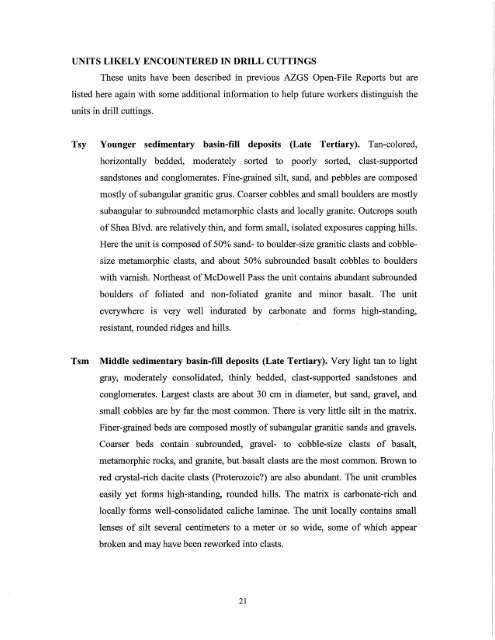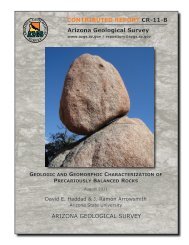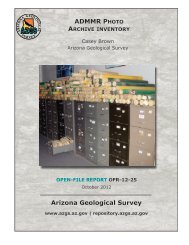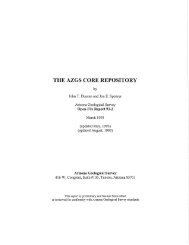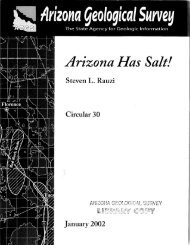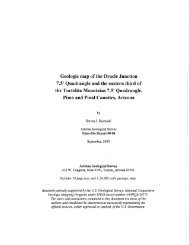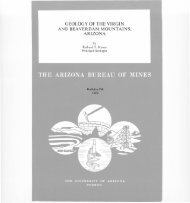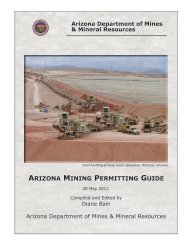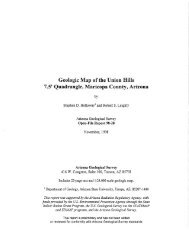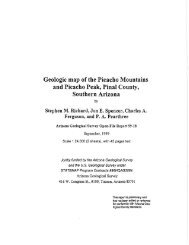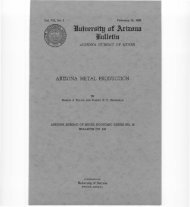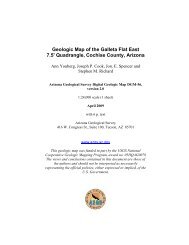Subsurface Geologic Investigation of Fountain Hills - AZGS ...
Subsurface Geologic Investigation of Fountain Hills - AZGS ...
Subsurface Geologic Investigation of Fountain Hills - AZGS ...
You also want an ePaper? Increase the reach of your titles
YUMPU automatically turns print PDFs into web optimized ePapers that Google loves.
UNITS LIKELY ENCOUNTERED IN DRILL CUTTINGS<br />
These units have been described in previous <strong>AZGS</strong> Open-File Reports but are<br />
listed here again with some additional information to help future workers distinguish the<br />
units in drill cuttings.<br />
Tsy Younger sedimentary basin-fill deposits (Late Tertiary). Tan-colored,<br />
horizontally bedded, moderately sorted to poorly sorted, clast-supported<br />
sandstones and conglomerates. Fine-grained silt, sand, and pebbles are composed<br />
mostly <strong>of</strong> sub angular granitic grus. Coarser cobbles and small boulders are mostly<br />
sub angular to subrounded metamorphic clasts and locally granite. Outcrops south<br />
<strong>of</strong> Shea Blvd. are relatively thin, and form small, isolated exposures capping hills.<br />
Here the unit is composed <strong>of</strong> 50% sand- to boulder-size granitic clasts and cobble<br />
size metamorphic clasts, and about 50% subrounded basalt cobbles to boulders<br />
with varnish. Northeast <strong>of</strong> McDowell Pass the unit contains abundant subrounded<br />
boulders <strong>of</strong> foliated and non-foliated granite and minor basalt. The unit<br />
everywhere is very well indurated by carbonate and forms high-standing,<br />
resistant, rounded ridges and hills.<br />
Tsm Middle sedimentary basin-fill deposits (Late Tertiary). Very light tan to light<br />
gray, moderately consolidated, thinly bedded, clast-supported sandstones and<br />
conglomerates. Largest clasts are about 30 ern in diameter, but sand, gravel, and<br />
small cobbles are by far the most common. There is very little silt in the matrix.<br />
Finer-grained beds are composed mostly <strong>of</strong> sub angular granitic sands and gravels.<br />
Coarser beds contain subrounded, gravel- to cobble-size clasts <strong>of</strong> basalt,<br />
metamorphic rocks, and granite, but basalt clasts are the most common. Brown to<br />
red crystal-rich dacite clasts (Proterozoic?) are also abundant. The unit crumbles<br />
easily yet forms high-standing, rounded hills. The matrix is carbonate-rich and<br />
locally forms well-consolidated caliche laminae. The unit locally contains small<br />
lenses <strong>of</strong> silt several centimeters to a meter or so wide, some <strong>of</strong> which appear<br />
broken and may have been reworked into clasts.<br />
21


